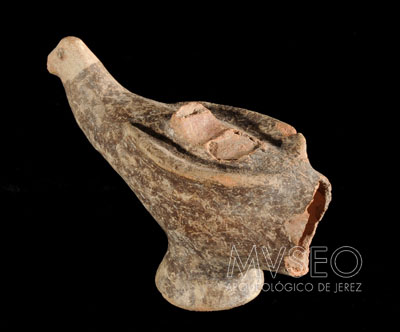DOVE-SHAPED ASPERSORIUM OR SITULA
Protohistory
DOVE-SHAPED ASPERSORIUM OR SITULA
Modelled pottery.
Height: 8.6 cm. Maximum length preserved: 13.6 cm. Maximum width: 5.3 cm. Diameter: 4.1 cm.
Protohistory. 5th-3rd century B.C.
Origin
Necropolis in Mesas de Asta. Jerez de la Frontera. Cádiz.
Description
Dove-shaped zoomorphic vessel, hollow interior, multi-perforated base and reddish/wine-coloured painting on body and eyes. Its cracked handle and base, means that was not used as a carrying system. Due to holes in the base, it was initially assumed to be a clepsydra (water clock) - not with a traditional clock function, but as a “water thief” intended to capture and distribute liquids in a controlled fashion. However, inside the body there is a conical piece that ends in a small hole on the upper part, which was made before firing. This distances the vessel from other clepsydrae known from this period. Instead, it is likely to be an aspersorium or situla to spread essence during ceremonial burials. This theory is supported by its discovery in the site's funeral area, although it was found from a superficial survey. Furthermore, the symbolic representations of doves are related to cult and ceremonial contexts.
Bibliography
- González Rodríguez, R. y Ruiz Mata, D. (1999): "Prehistoria e Historia antigua de Jerez". Historia de Jerez de la Frontera. Vol I (Coord. Caro, D.). Diputación de Cádiz, pp 105-106.

